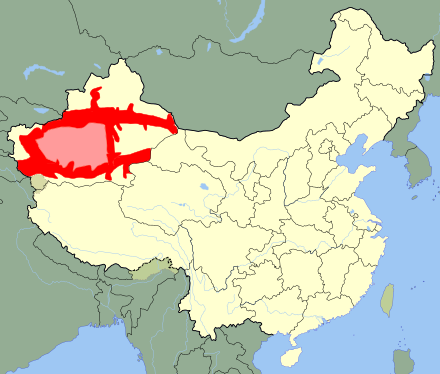أويغور (لغة)
| Uyghur | |
|---|---|
| ئۇيغۇرچە / ئۇيغۇر تىلى | |
 Uyghur written in Perso-Arabic script | |
| النطق | [ʊjʁʊrˈtʃɛ], [ʊjˈʁʊr tili] |
| موطنها | Xinjiang Uyghur Autonomous Region, China |
| العرق | Uyghur |
الناطقون الأصليون | 10.4 million (2010 census)e18 |
الصيغ المبكرة | Karakhanid
|
| Arabic (Uyghur alphabet), Latin script, cyrillic script | |
| الوضع الرسمي | |
لغة رسمية في | Xinjiang Uyghur Autonomous Region, China[1] |
| ينظمها | Working Committee of Ethnic Language and Writing of Xinjiang Uyghur Autonomous Region |
| أكواد اللغات | |
| ISO 639-2 | uig |
| ISO 639-2 | uig |
| ISO 639-3 | uig |
| Glottolog | uigh1240 |
 Geographical extent of Uyghur in China | |
Uyghur or Uighur /ˈwiːɡər/[2][3] (ئۇيغۇر تىلى Uyghur tili, ئۇيغۇرچە Uyghurche),[4][5] formerly known as Eastern Turki, is a Turkic language with 8 to 11 million speakers, spoken primarily by the Uyghur people in the Xinjiang Uyghur Autonomous Region of Western China. Significant communities of Uyghur-speakers are located in Kazakhstan and Uzbekistan, and various other countries have Uyghur-speaking expatriate communities. Uyghur is an official language of the Xinjiang Uyghur Autonomous Region, and is widely used in both social and official spheres, as well as in print, radio, and television, and is used as a lingua franca by other ethnic minorities in Xinjiang.[بحاجة لمصدر]
Uyghur belongs to the Karluk branch of the Turkic language family, which also includes languages such as Uzbek. Like many other Turkic languages, Uyghur displays vowel harmony and agglutination, lacks noun classes or grammatical gender, and is a left-branching language with subject–object–verb word order. More distinctly Uyghur processes include, especially in northern dialects, vowel reduction and umlauting. In addition to influence of other Turkic languages, Uyghur has historically been influenced strongly by Persian and Arabic, and more recently by Mandarin Chinese and Russian.
The Arabic-derived writing system is the most common and the only standard in China, although other writing systems are used for auxiliary and historical purposes. Unlike most Arabic-derived scripts, the Uyghur Arabic alphabet has mandatory marking of all vowels. Two Latin and one Cyrillic alphabet are also used, though to a much lesser extent. The Arabic and Latin alphabets both have 32 characters.
History
The Middle Turkic languages are the direct ancestor of the Karluk languages, including Uyghur and the Uzbek language.
Modern Uyghur is not descended from Old Uyghur, rather, it is a descendant of the Karluk language spoken by the Kara-Khanid Khanate.[6] Western Yugur is considered to be the true descendant of Old Uyghur, and is also called "Neo-Uyghur". Modern Uyghur is not a descendant of Old Uyghur, but is descended from the Xākānī language described by Mahmud al-Kashgari in Dīwānu l-Luġat al-Turk.[7] Modern Uyghur and Western Yugur belong to entirely different branches of the Turkic language family, respectively the southeastern Turkic languages and the northeastern Turkic languages.[8][9] The Western Yugur language, although in geographic proximity, is more closely related to the Siberian Turkic languages in Siberia.[10]
التبويب
تنتمي اللغة الويغورية إلى فرع توركية القارلوق (Karluk أو Qarluq) من عائلة اللغات التوركية. وتقترن بشدة بلغات آينو Äynu, لوپ Lop، إيلي تركي، ولغة الچقطاي المنقرضة (لغات القارلوق الشرقية)، وبشكل أبعد إلى الأوزبكية (التي هي قارلوق غربية).
الوضع

انظر أيضاً
الهامش
- ^ "China". Ethnologue.
- ^ "Uyghur - definition of Uyghur by the Free Online Dictionary, Thesaurus and Encyclopedia". The Free Dictionary. Retrieved 5 October 2013.
- ^ "Define Uighur at Dictionary.com". Dictionary.com. Retrieved 5 October 2013.
- ^ In English, the name of the ethnicity and its language is spelled variously as Uyghur, Uighur, Uygur and Uigur, with the preferred spelling being Uyghur.
- ^ Its name in other languages in which it might be often referred to is as follows:
- الصينية المبسطة: 维吾尔语; الصينية التقليدية: 維吾爾語; پنين: Wéiwú'ěryǔ in Chinese
- Уйгурский (язык) (transliteration: Uygurskiy (yazyk)) in Russian.
- ^ Arik, Kagan (2008). Austin, Peter (ed.). One Thousand Languages: Living, Endangered, and Lost (illustrated ed.). University of California Press. p. 145. ISBN 0520255607. Retrieved 10 March 2014.
- ^ Clauson, Gerard (Apr 1965). "Review An Eastern Turki-English Dictionary by Gunnar Jarring". The Journal of the Royal Asiatic Society of Great Britain and Ireland. Royal Asiatic Society of Great Britain and Ireland (No. 1/2): 57. Retrieved 30 March 2014.
{{cite journal}}:|issue=has extra text (help); line feed character in|title=at position 8 (help) - ^ Coene, Frederik (2009). The Caucasus - An Introduction. Routledge Contemporary Russia and Eastern Europe Series. Routledge. p. 75. ISBN 1135203024. Retrieved 10 March 2014.
- ^ Coene, Frederik (2009). The Caucasus - An Introduction. Routledge Contemporary Russia and Eastern Europe Series (illustrated, reprint ed.). Taylor & Francis. p. 75. ISBN 0203870719. Retrieved 10 March 2014.
- ^ Hahn 1998, pp. 83–84
وصلات خارجية
قواميس
- Uyghur–Chinese Dictionary
- Online Uyghur-English Multiscript Dictionary
- Online Uyghur, English, Chinese Multi-directional Dictionary (Arabic Alphabet)
- Free Uighur Dictionary
- English/Chinese/French ↔ Uyghur translation services
الراديو
التلفزيون
الفونتات
- Articles containing simplified Chinese-language text
- Articles containing traditional Chinese-language text
- Articles containing روسية-language text
- CS1 errors: invisible characters
- CS1 errors: extra text: issue
- Articles with hatnote templates targeting a nonexistent page
- Articles containing Uyghur-language text
- Pages with plain IPA
- Languages with ISO 639-2 code
- Languages with ISO 639-1 code
- Language articles with unsupported infobox fields
- Articles with unsourced statements from November 2011
- اللغة الأويغورية
- لغات إلصاقية
- اللغات التوركية
- لغات الصين
- لغات پاكستان
- لغات قزخستان
- لغات قيرغيزستان
- Vowel-harmony languages